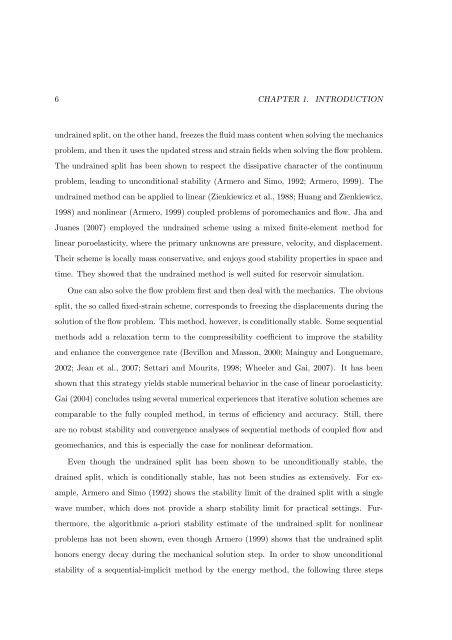Sequential Methods for Coupled Geomechanics and Multiphase Flow
Sequential Methods for Coupled Geomechanics and Multiphase Flow
Sequential Methods for Coupled Geomechanics and Multiphase Flow
You also want an ePaper? Increase the reach of your titles
YUMPU automatically turns print PDFs into web optimized ePapers that Google loves.
6 CHAPTER 1. INTRODUCTION<br />
undrained split, on the other h<strong>and</strong>, freezes the fluid mass content when solving the mechanics<br />
problem, <strong>and</strong> then it uses the updated stress <strong>and</strong> strain fields when solving the flow problem.<br />
The undrained split has been shown to respect the dissipative character of the continuum<br />
problem, leading to unconditional stability (Armero <strong>and</strong> Simo, 1992; Armero, 1999). The<br />
undrained method can be applied to linear (Zienkiewicz et al., 1988; Huang <strong>and</strong> Zienkiewicz,<br />
1998) <strong>and</strong> nonlinear (Armero, 1999) coupled problems of poromechanics <strong>and</strong> flow. Jha <strong>and</strong><br />
Juanes (2007) employed the undrained scheme using a mixed finite-element method <strong>for</strong><br />
linear poroelasticity, where the primary unknowns are pressure, velocity, <strong>and</strong> displacement.<br />
Their scheme is locally mass conservative, <strong>and</strong> enjoys good stability properties in space <strong>and</strong><br />
time. They showed that the undrained method is well suited <strong>for</strong> reservoir simulation.<br />
One can also solve the flow problem first <strong>and</strong> then deal with the mechanics. The obvious<br />
split, the so called fixed-strain scheme, corresponds to freezing the displacements during the<br />
solution of the flow problem. This method, however, is conditionally stable. Some sequential<br />
methods add a relaxation term to the compressibility coefficient to improve the stability<br />
<strong>and</strong> enhance the convergence rate (Bevillon <strong>and</strong> Masson, 2000; Mainguy <strong>and</strong> Longuemare,<br />
2002; Jean et al., 2007; Settari <strong>and</strong> Mourits, 1998; Wheeler <strong>and</strong> Gai, 2007). It has been<br />
shown that this strategy yields stable numerical behavior in the case of linear poroelasticity.<br />
Gai (2004) concludes using several numerical experiences that iterative solution schemes are<br />
comparable to the fully coupled method, in terms of efficiency <strong>and</strong> accuracy. Still, there<br />
are no robust stability <strong>and</strong> convergence analyses of sequential methods of coupled flow <strong>and</strong><br />
geomechanics, <strong>and</strong> this is especially the case <strong>for</strong> nonlinear de<strong>for</strong>mation.<br />
Even though the undrained split has been shown to be unconditionally stable, the<br />
drained split, which is conditionally stable, has not been studies as extensively. For ex-<br />
ample, Armero <strong>and</strong> Simo (1992) shows the stability limit of the drained split with a single<br />
wave number, which does not provide a sharp stability limit <strong>for</strong> practical settings. Fur-<br />
thermore, the algorithmic a-priori stability estimate of the undrained split <strong>for</strong> nonlinear<br />
problems has not been shown, even though Armero (1999) shows that the undrained split<br />
honors energy decay during the mechanical solution step. In order to show unconditional<br />
stability of a sequential-implicit method by the energy method, the following three steps
















